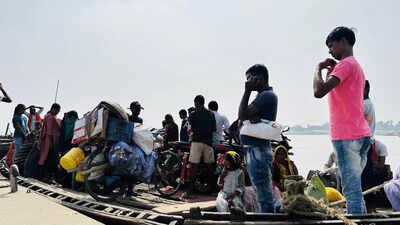ARTICLE AD BOX

People of Rustampur under Raghopur assembly constituency cross the Ganga daily with their motorcycles on boats, relying on this lifeline in the absence of a permanent bridge
Raghopur: Barely 21km from Bihar’s power centre Pana, Raghopur, the political home of RJD chief Lalu Prasad’s younger son Tejashwi Prasad Yadav, floats on fragile boats of faith and patience. For thousands here, the wooden boats that cut across the Ganga are not symbols of leisure but lifelines.
Each day, they ferry students to colleges, workers to markets and patients to hospitals across the river.
On a bright afternoon, men, women and children, decked in festive colours, stood shoulder to shoulder on a creaking boat laden with motorcycles and sacks of goods, as the skyline of Patna shimmered faintly across the hazy expanse.For nearly 25,000 residents of Rustampur village, this has been the rhythm of life for decades — half anchored to the river, half adrift in hope.Raghopur is now at the heart of Bihar’s political drama as Grand Alliance’s chief ministerial candidate Tejashwi contests the seat for the third time, challenging Nitish Kumar’s long reign. The 35-year-old RJD leader, burdened with both legacy and expectation, carries not only his party’s campaign but the entire opposition’s hopes. With Lalu ailing and his elder brother estranged, the younger Yadav stands as the Grand Alliance’s central figure.
Tejashwi is striving to reshape his party’s image – from his father’s populist, charisma-driven politics to one promising jobs, welfare and development. He has pledged a govt job for one member in every jobless family and a monthly allowance of Rs 2,500 for women. “The people of Raghopur are not going to choose just an MLA but the next chief minister of Bihar,” he said on Friday while inaugurating an RJD campaign office in Chaksikandar village.
He reiterated promises of “one permanent govt job to every family without a govt job” and “Rs 2,500 monthly assistance to women.”However, scepticism lingers. “He was deputy chief minister for years. Why didn’t he change the fate of this constituency — let alone his own community?” asked Ram Parvesh Singh, a migrant worker home from Pune for the festival.Raghopur goes to polls on Nov 6, but residents say Tejashwi’s physical absence hardly matters.
“He enjoys huge support here,” said a local RJD worker, adding that the Yadavs, the RJD’s loyal backbone, dominate the constituency.Since 1995, Raghopur has rarely escaped the Yadav family’s hold. Lalu won in 1995 and 2000, Rabri Devi in 2005 and Tejashwi in 2015 and 2020. Only once, in 2010, did the family lose — when JD(U)’s Satish Kumar Yadav defeated Rabri Devi by 13,006 votes. Satish Kumar Yadav, now with the BJP, has returned to the battlefield this year, hoping to recreate his upset.
Jan Suraaj, meanwhile, has fielded Chanchal Singh after its founder Prashant Kishor withdrew his earlier plan to contest from Raghopur.Despite the Yadav family’s long political reign, Raghopur remains caught between floods and neglect. Each monsoon, the swelling Ganga swallows parts of villages like Rustampur and Bahrampur. The peepa pul — a makeshift floating bridge built with iron drums and wooden planks — operates only four to five months a year, when the river recedes.
The nearest permanent bridge is far away, making travel to Patna expensive and arduous.Yet, gratitude endures amid hardship. “Who gave us the peepa pul? Who saved our homes?” asked Dharamdeo Rai, a middle-aged farmer in a white baniyan and yellow gamcha, rubbing tobacco between his palms. “It was Tejashwi. If he can give us this, he will also give us a permanent bridge when RJD comes to power,” he said. RJD district vice president Krishna Kumar Das said, “Many villages were saved from the Ganga’s fury only because Tejashwi got boulder fitting done.
He can do better when he becomes chief minister.”Raghopur’s poverty speaks louder than its politics. Mud-walled homes lean into narrow lanes; a few brick structures peek through the decay. Tin-roofed huts and straw shelters line the roadsides, while children splash in shallow ponds, their laughter punctuating the gloom. Livelihoods rely on cattle, small-scale farming, or migration to cities like Delhi and Pune when fields fail.“Even basic healthcare is a luxury here,” said Birendra Rai, 25, from Rampur village, his face swathed in a gamcha as he waited outside Mohanpur referral hospital. “I met with an accident last night and hurt my face, arms, and legs. It’s 11am, but the doctor hasn’t come yet,” he said. Rai, a factory worker in Pune, has returned home for Chhath.Raghopur remains a mirror to Bihar itself — rich in loyalty, poor in infrastructure. As the overloaded boats sway across the Ganga, the contrast is striking. On one bank stands Patna, draped in flyovers and power. On the other, Raghopur waits – faithful and patient – for its turn at progress.

 10 hours ago
4
10 hours ago
4









 English (US) ·
English (US) ·